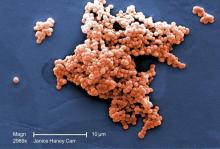It once was a very a common scenario. A baby born at term looks fine for the first 24 hours of life. Without much warning, the infant develops grunting, tachypnea, and tachycardia. Sepsis is suspected, and within a few hours, group B streptococcus (GBS) is isolated from a blood culture.
In the 1970s, roughly 2 of every 1,000 live-born infants developed early-onset GBS with mortality of 2%-8% in term infants and as high as 30% in preterm infants. Clinical trials conducted in the 1980s demonstrated that giving intrapartum penicillin or ampicillin to mothers at risk for transmitting GBS to their babies prevented early-onset GBS disease. In 1992, the American Academy of Pediatrics advocated screening all pregnant women at 26-28 weeks’ gestation for GBS colonization and selectively providing intrapartum antibiotics to those with specified risk factors (Pediatrics. 1992 Nov;90[5]:775-8). The AAP, the Centers for Disease Control and Prevention, and the American College of Obstetricians and Gynecologists released consensus guidelines for the prevention of perinatal GBS disease in 1996. These were revised in 2002, and again in 2010 (Pediatrics. 2011 Aug. doi: 10.1542/peds.2011-1466). As every pediatrician knows, current guidelines recommend screening of all pregnant women at 35-37 weeks’ gestation for vaginal and rectal GBS colonization and intrapartum treatment of almost all of those who are colonized.According to the CDC, a woman colonized with Group B strep at the time of delivery has a 1 in 200 chance of delivering a baby who will develop GBS disease. Antibiotics during labor drop that risk to 1 in 4,000. It’s not perfect – there are still about 1,000 cases annually in the United States – but is has been a major step forward. In recent years, the incidence of early-onset GBS disease has fallen to just under 0.3 cases per 1,000 live births, and some experts think rates could go even lower with improved adherence to current guidelines.
On a related note, the way doctors practice medicine has been transformed over the last 50 years, in large part because of the tools we have to assist with decision-making. or which babies needed blood cultures or empiric antibiotic therapy? But that’s exactly what the CDC’s Prevent Group B Strep app does.Reducing late-onset GBS disease requires a different strategy. Efforts to develop a GBS vaccine that could be given to pregnant women continue, and recent phase 2 trials of a trivalent polysaccharide-protein conjugate vaccine looked promising. Fingers crossed that we won’t have to wait until we celebrate the 75th anniversary of Pediatric News to tout the impact of maternal immunization on reducing GBS disease in infants.
Dr. Bryant is a pediatrician specializing in infectious diseases at the University of Louisville (Ky.) and Norton Children’s Hospital, also in Louisville. She said she had no relevant financial disclosures. Email her at pdnews@frontlinemedcom.com.



